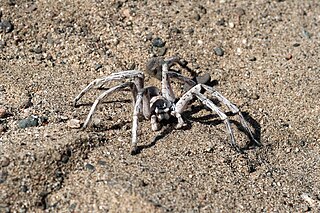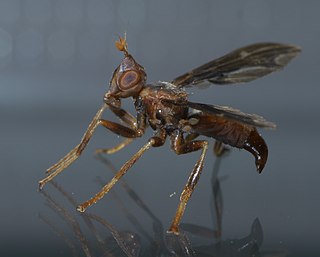
Ground spiders comprise Gnaphosidae, the seventh largest spider family with nearly 2,000 described species in over 100 genera distributed worldwide. There are 105 species known to central Europe, and common genera include Gnaphosa, Drassodes, Micaria, Cesonia, Zelotes and many others. They are closely related to Clubionidae. At present, no ground spiders are known to be seriously venomous to humans.
Cavillator is a monotypic genus of Zimbabwean jumping spiders containing the single species, Cavillator longipes. It was first described by Wanda Wesołowska in 2000, and is only found in Zimbabwe.
Lamottella is a spider genus of the jumping spider family, Salticidae. Its single described species, Lamotella longipes, is found in Guinea.
Agelena longipes is a species of spider in the family Agelenidae, which contains 1146 species of funnel-web spiders. It was first described by Carpenter, 1900. It is primarily found in England.
Agelena funerea is a species of spider in the family Agelenidae, which contains 1146 species of funnel-web spiders. It was first described by Simon, in 1909. It is primarily found in East Africa.

Micaria is a genus of ground spiders that was first described by Niklas Westring in 1851. They are 1.3 to 6.5 millimetres long.

Micaria pulicaria, the glossy ant spider, is a species of ground spider from the family Gnaphosidae with a Holarctic distribution.

Orchestrella is a genus of Namibian huntsman spiders that was first described by R. F. Lawrence in 1965. As of September 2019 it contains two species, found in Namibia: O. caroli and O. longipes.
Anibontes is a genus of North American dwarf spiders that was first described by Ralph Vary Chamberlin in 1924. As of May 2019 it contains only two species, both found in the United States: A. longipes and A. mimus.
Micaria rossica is a spider in the family Gnaphosidae, in the infraorder Araneomorphae . The distribution range of Micaria rossica includes North America, Europe, Turkey, Caucasus, Russia to Central Asia, and China.
Micaria pasadena is a species of ground spider in the family Gnaphosidae. It is found in the United States and Mexico.
Stenoscinis longipes is a species of frit fly in the family Chloropidae.
Chelonychus longipes is a species of true weevil in the beetle family Curculionidae. It is found in North America.
Micaria gertschi is a species of ground spider in the family Gnaphosidae. It is found in the United States and Canada.
Anabrus longipes, the long-legged anabrus, is a species of shield-backed katydid in the family Tettigoniidae. It is found in North America.
Micaria longispina is a species of ground spider in the family Gnaphosidae. It is found in the United States and Canada.

Pyrgota is a genus of flies in the family Pyrgotidae. There are about 10 described species in Pyrgota.

Scytodes longipes is a species of spitting spider in the family Scytodidae. It is found in Southern America, has been introduced into Pacific Islands, Guinea, Congo, Indonesia, and Australia (Queensland).
Allende is a genus of South American long-jawed orb-weavers that was first described by F. Álvarez-Padilla in 2007.






